John Bengtson's Blog, page 8
January 23, 2021
The Lens of History – Hollywood before the Chaplin Studio
Above, only part of a vast panoramic view looking south at Hollywood, circa 1906. Can you spot the future site of the Charlie Chaplin Studio, nearly straight ahead? The hill in the foreground would become in 1914 the site to the Bernheimer brothers massive Japanese mansion and gardens, today known as the popular restaurant Yamashiro. Click to enlarge each image. Huntington Digital Library.
A closer view, Orange Drive leads away south to the far left. Running straight north-south for miles, La Brea bends to the NW at the corner of Sunset. This view is a component of the same panorama above, only this time USC Digital Library.
The home facing us to the left of the yellow line (7022 Sunset), had 10 rows of citrus trees. To the right of the yellow line, the future Chaplin Studio site had 7 rows of trees. The far white line at back is De Longpre Avenue, the right white line is La Brea. The one-story home with a single gable standing on the studio site (7062 Sunset), was relocated in July 1914 to accommodate a much larger two-story mansion built in 1914. The mansion came with the sale of the property, and Charlie’s half-brother Syd Chaplin would live there. Starting construction late in 1917, Chaplin dedicated his studio on January 21, 1918.
Looking NE – 7022 Sunset, the home to the right of the yellow line, had 10 rows of citrus trees. To the left of the yellow line, 7 rows of trees stand on the Chaplin Studio. Note Syd Chaplin’s multi-gabled mansion beside the studio tennis court. The studio address is 1416 N. La Brea, now home to the Jim Henson Company. Charlie Chaplin Archive.
Again, just part of a similar vast panorama, circa 1918, this time taken from the Bernheimer Estate. Huntington Digital Library.
Can you spot the studio site? This photo likely pre-dates 1918, as the one-story home relocated from the site in 1914 still seems to appear in this view.
Assembled from Chaplin’s pseudo documentary How to Make Movies (1918), this view looks north from De Longpre at the studio site. La Brea runs north at the left.
Jumping a decade ahead, here’s a view east of the Chaplin Studio during the production of The Circus (1928). Note how La Brea bends left (NW) at Sunset, the remaining orchard and tennis court beside Syd’s 7062 Sunset Boulevard mansion, and the giant circus tent set. Buster Keaton filmed a scene from Cops (1922) at the corner of Sunset and Detroit at the lower left of this view – more below. Charlie Chaplin Archive.
Above, a 1927 view of Hollywood – click to enlarge. The Yamashiro site (somewhat dark) stands at center. What else do you see? Huntington Digital Library.
Does this help? The same component of the panorama above, again this time from USC Digital Library.
Pointers highlight the circus tent set at left, and studio tennis court. The inset photos show the studio along La Brea and Buster filming Cops at the corner of Sunset and Detroit.


Matching views south and east of Buster filming on Sunset at the corner of Detroit.
Vintage photos help us to envision the once open and rural landscapes of early Hollywood. To conduct your own photo time-travel safari, I highly recommend using Calisphere, a gateway site that allows you to search simultaneously the digital collections from California’s great libraries, archives, and museums.
Charlie, Buster, and Harold each filmed a masterpiece at an alley you can still visit today. Please help support naming the alley by posting a review on Google Maps. Prototype alley sign design by noted Dutch graphic artist – Piet Schreuders. Download a 4-page brochure about the alley HERE. This video further explains the alley – if you can, please leave a thumbs up and share it with others.
Below, a matching view north of the studio site – things sure have changed.
January 13, 2021
Live Virtual Silent Locations Tour with Esotouric
This Saturday January 16, at noon PST, Esotouric, L.A.’s most eclectic sightseeing tour company, is hosting my live virtual silent cinema scavenger hunt through L.A.’s historic Westlake neighborhood. Though webcast live, the event may be viewed later. Click the link below for details.
Silent Echoes Westlake Virtual Tour
I had fun working with Esotouric’s Kim Cooper and Richard Schave before, when we did all-day bus tours of silent movie locations back in 2019, and hope to resume such tours in the near future when circumstances allow. But until then we’ll be hosting a virtual tour around Westlake, showing how Charlie, Buster, and Harold all filmed there. I hope you can join us then.
December 27, 2020
Mary Pickford’s “A Beast at Bay” a century before LAX
Mary Pickford’s A Beast at Bay (1912), directed by D.W. Griffith, portends his 1916 feature Intolerance, overlaps with later films starring Mabel Normand, Douglas Fairbanks, and Buster Keaton, and reveals the future site of LAX (!), the Los Angeles International Airport. But faint-hearted viewers in 1912 also complained its cinematic race filmed from speeding cars along bumpy roads was “an abominable practice” – see more below.
Beautifully preserved and visually stunning, and posted on YouTube by The Mary Pickford Foundation, the movie portrays Mary’s kidnapping, and thrilling pursuit by her rescuers, while providing vivid images of the primitive Inglewood and Wiseburn train stops, the isolated dirt road running beside the Santa Fe rail line connecting them, and the vast open expanses of the historic Rancho Sausal Redondo that would grow into Mines Aviation Field, and later become LAX.
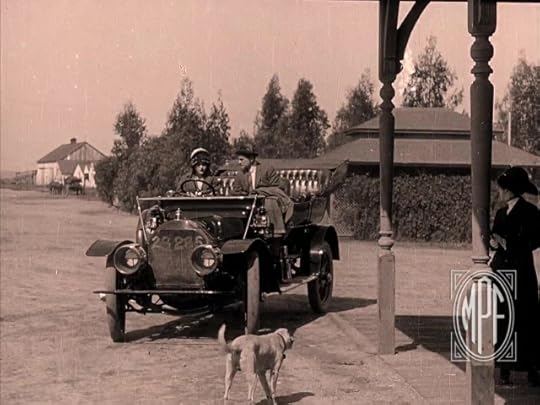

Driving beside the Inglewood Station, with a shameless dog sauntering into view, Mary calls potential beau Edwin August a coward for refusing to fight with a drunken bum. Viewed looking west, she dumps Edwin at the SW corner of the station portico, the farthest corner (blocked from view) in the matching photo. Noted Biograph scholar Russell Merritt reports with this film plucky young Mary became the first Biograph player ever to pilot an automobile onscreen. Before this the company hired anonymous chauffeurs to drive the actors. The station once stood at 320 N. Eucalyptus Ave. in Inglewood, just north of the extant rail line.


Left behind after Mary drives away, Edwin can’t believe his eyes. Far off, an escaped convict has grabbed Mary, forcing her to drive him from a police search party. As seen above, a low-fenced garden once decorated the east side of the Inglewood station.

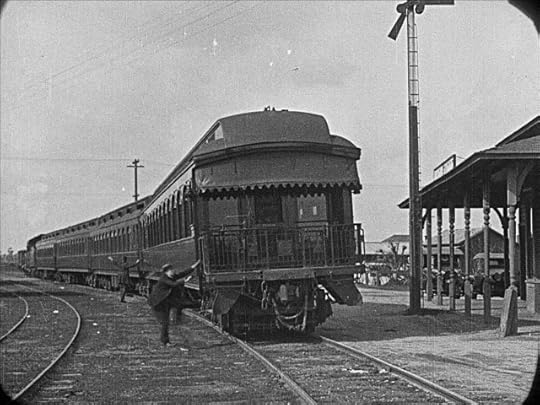
The police scan Mary driving away with the convict, paired with a matching view looking west of Buster Keaton fleeing the police in The Goat (1921).


The large warehouse, with central doorway appearing behind Edwin, stands roofless nine years later as Buster’s train heads west from Inglewood in The Goat.

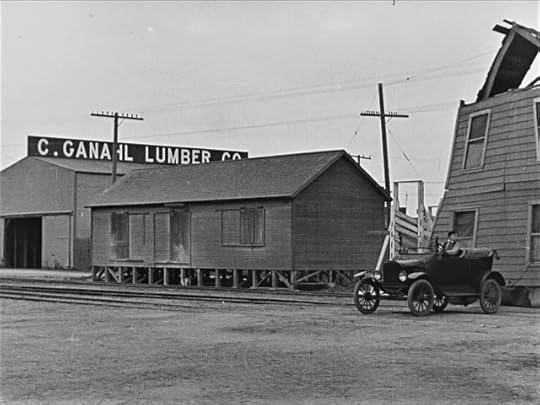
Without access to a car, Edwin and the police convince an engineer to follow Mary in his locomotive. Looking east, once the train departs the station, it reveals the C. Ganahl Lumber Co., also appearing when Buster Keaton tows his house north up Eucalyptus Ave. across the tracks at the conclusion of One Week (1920).



Matching views east of the Inglewood station, a very popular filming site. Above left, dastardly Ford Sterling plots to tie poor Mabel Normand to the railroad tracks in the Mack Sennett comedy Barney Oldfield’s Race for a Life (1913). Center, Buster and Sybil Seely bid farewell to their demolished home in One Week. Above right, a dozen years later Keaton returned here for Speak Easily (1932), where he was filmed dragged away by a departing train (read more HERE).
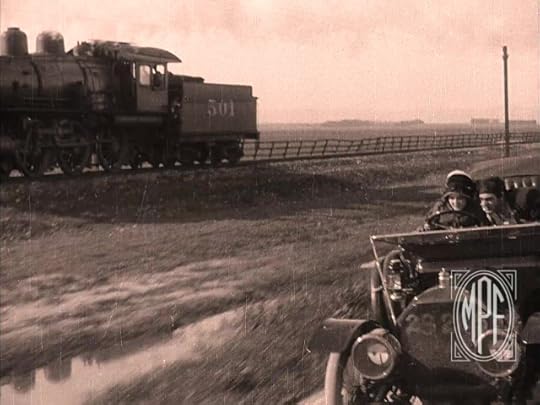
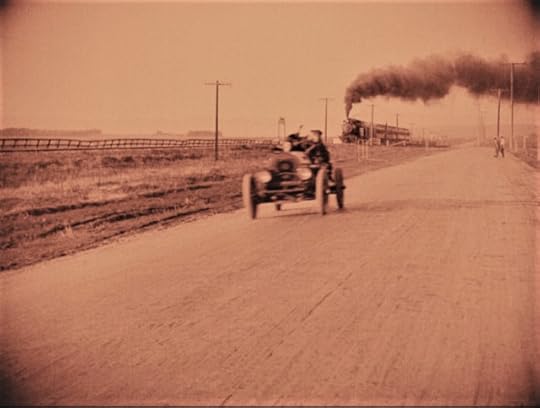


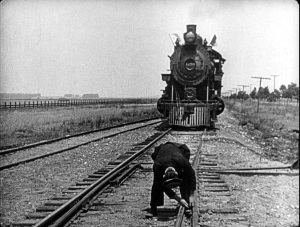 Above, the race is on. Matching views north up Redondo Blvd. beside the tracks, with Mary and the convict, left, and the race to stop the Governor’s train during Intolerance, upper right, and Ford tying Mabel to the tracks in Barney Oldfield’s Race for a Life, lower right. Notice the distinctive tree windbreaks at back, also appearing behind Buster as he blithely extricates his stuck foot during The Blacksmith (1922).
Above, the race is on. Matching views north up Redondo Blvd. beside the tracks, with Mary and the convict, left, and the race to stop the Governor’s train during Intolerance, upper right, and Ford tying Mabel to the tracks in Barney Oldfield’s Race for a Life, lower right. Notice the distinctive tree windbreaks at back, also appearing behind Buster as he blithely extricates his stuck foot during The Blacksmith (1922).

A 1929 NE view of developing Mines Airfield. The five scenes above were staged looking north along Redondo (now Aviation) Blvd. (arrow), with the distinctive windbreak trees once standing south of W. Manchester Ave. marked in yellow. Mostly running parallel to the tracks, the dirt road splits away from the tracks at a 60 degree turn “A” above, then rejoins the tracks with two 90 degree turns, “B” above, discussed further below. LAPL.




Above upper left, Mary’s rescuers arrive at Wiseburn, matched with Intolerance upper right, as friends halt the Governor’s train, seeking his last-minute reprieve from execution for the innocent, wrongly condemned Robert Harron (The Boy). Below, speeding directly toward the camera, Buster arrives in style at Wiseburn during The Goat, one of Keaton’s most iconic scenes.


For good measure, Douglas Fairbanks filmed scenes for The Matrimaniac (1916) at Wiseburn, mentioned by name during the film, as he attempts to sneak a preacher onto the train to officiate Doug’s stealth elopement. Since Wiseburn was simply a crude agricultural loading dock in the middle of nowhere (now the western end of W. 120th St.), Doug’s insert shots beside the Wiseburn “station” were staged miles away instead at former the Pasadena Station, where Buster Keaton filmed other scenes for The Goat and Go West (1925), and where Charlie Chaplin filmed the opening scenes from The Idle Class (1921).
Aside from the locations, it was fun to read A Beast at Bay reviewed as “A melodramatic picture existing chiefly to show a race between an automobile and a locomotive,” with “serviceable” camerawork, and neither Mary nor D.W. warranting a mention by name. The Moving Picture World – June 8, 1912, page 944.
But two months later the film’s “serviceable” camerawork was excoriated by seemingly the world’s most easily offended snowflake, Mr. James J. Wood, who registered his “vigorous protest against the abominable practice” of filming from 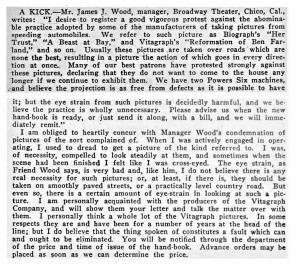 speeding automobiles. “[T]he eye strain from such pictures is decidedly harmful.” He also takes offense at The Girl and “Her Trust” [sic], another Griffith Biograph thriller filmed along the same rail line, showing a brief tight glimpse of the Inglewood Station porch. The Moving Picture World – August 3, 1912, page 449. Click to enlarge.
speeding automobiles. “[T]he eye strain from such pictures is decidedly harmful.” He also takes offense at The Girl and “Her Trust” [sic], another Griffith Biograph thriller filmed along the same rail line, showing a brief tight glimpse of the Inglewood Station porch. The Moving Picture World – August 3, 1912, page 449. Click to enlarge.
The publication’s editor was “obliged to heartily concur” with Mr. Wood’s condemnation of shooting films along bumpy roads, “a fault which can and ought to be eliminated.” How dare they? “[Films] should be taken on smoothly paved streets.” Now pardon me while I retire to my fainting couch, oh mercy me!

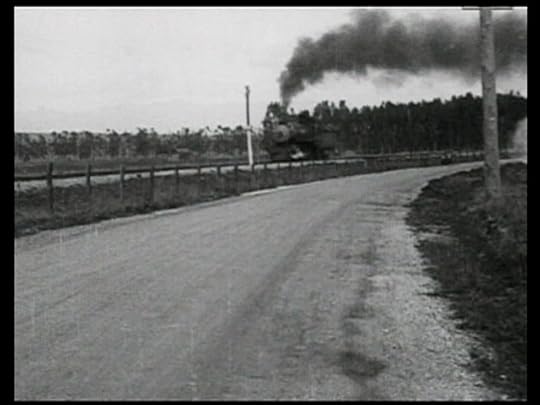
For historical completeness these remaining images document the route of the tracks and dirt road once running from Inglewood to Wiseburn. Above, Mary’s view matched with Barney Oldfield’s Race for a Life, both looking NE, west of the Inglewood station, as the tracks and dirt road (modern W. Florence Ave.) curve to the southwest, approaching the “A” marker on the aerial photo further above.


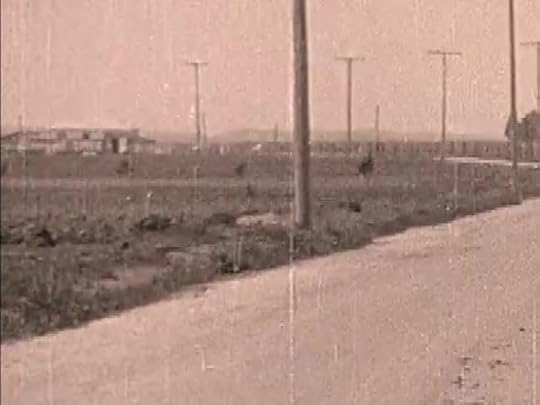
Mary’s kidnapping shows the same curve in the road seen above, only a reverse POV looking west as the tracks and road bend left (south). The low structures to the upper left of the main frame are identified on maps as “hothouses.”
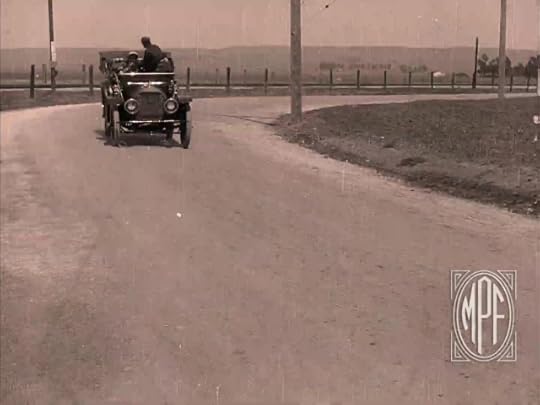

Above left, while the tracks continue to gently curve to the southwest, the dirt road makes a 60 degree turn due south, splitting away from the tracks at the “A” marker on the above aerial view (where modern W. Florence Ave. turns and ends at W. Manchester Ave.) The hothouses identified on the map stand off camera to the right. The upper right frame is the same road before it splits south, essentially forming a panoramic view with the left image.


After traveling south for two blocks while separated from the tracks, the road makes a 90 degree turn right (west) (where modern Aviation Blvd. turns right at W. Arbor Vitae St.), then a 90 degree turn left (south), to rejoin its due south path directly adjacent to the tracks, the “B” marker on the above aerial view. These scenes from Mary, and Barney Oldfield’s Race for a Life, show the zig and zag as the road realigns with the tracks.



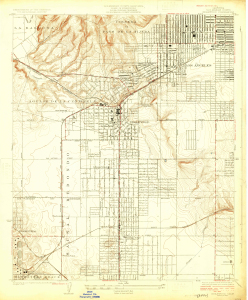 The upper left frame shows the train approaching the Wiseburn station, note the vertical “station” sign. Here, the tracks and the road split apart, straddling the station in between. The upper right and lower right frames above show both sides of the same one-story warehouse on the north side of the station, already torn down by the time Intolerance filmed here in 1916. If curious, click to enlarge
The upper left frame shows the train approaching the Wiseburn station, note the vertical “station” sign. Here, the tracks and the road split apart, straddling the station in between. The upper right and lower right frames above show both sides of the same one-story warehouse on the north side of the station, already torn down by the time Intolerance filmed here in 1916. If curious, click to enlarge 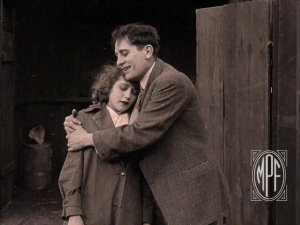 this giant 1924 USGS topological map, clearly identifying the stations and the route of the tracks and dirt road. No surprise, Edwin proves himself a hero rescuing Mary from the convict, and the film fades with the couple’s embrace.
this giant 1924 USGS topological map, clearly identifying the stations and the route of the tracks and dirt road. No surprise, Edwin proves himself a hero rescuing Mary from the convict, and the film fades with the couple’s embrace.

Bookend train crashes from One Week (left) and Parlor, Bedroom and Bath (1931).
In closing, Keaton also staged the famous car crash scene from Parlor, Bedroom, and Bath along the same Redondo Blvd., at the SE corner of Mines Field (read post HERE).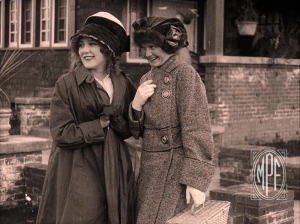
Highly recommended, A Beast at Bay is fun, entertaining, stunningly clear, with Mary a delight, while also a priceless documentary record of the vast rural expanse that was once greater Los Angeles well over a century ago. Great thanks to The Mary Pickford Foundation for posting it.
Charlie, Buster, and Harold each filmed a masterpiece at an alley you can still visit today. Please help support naming the alley by posting a review on Google Maps. Prototype alley sign design by noted Dutch graphic artist – Piet Schreuders. Download a 4-page brochure about the alley HERE. This video further explains the alley – if you can, please leave a thumbs up and share it with others.
Below, a view looking north at the former site of the Wiseburn station, at W. 120th St. and Aviation Blvd., the one-time filming site for Mary, D.W., Buster, and Doug.
December 6, 2020
Buster’s Brazen Bystanders
[image error]Bystanders appear frequently in the background of early films, a charming reminder of how the public witnessed the cinematic artform blossom, not only in theaters, but before their very eyes on the streets where they were made. The young girls caught on camera intently watching Charlie Chaplin through a window while he filmed The Kid (1921) (read more HERE) remains an all-time favorite discovery. Since Buster Keaton filmed so frequently on real streets, it’s not surprising onlookers appear throughout his films too. While there are many more, here are a few of the brazen bystanders to appear with Keaton in Cops (1922).


Buster’s encounter assisting Big Joe Roberts into a taxi, and pocketing his wallet, was filmed both in the late afternoon beside 590 N. Vermont (reported HERE), and in the early morning, above, miles away beside 7130 W. Sunset (reported HERE) looking east. Frozen in place, a woman stands unnoticed directly behind Buster at the corner of Sunset and Detroit to witness Joe retrieve his wallet, but not his cash.
[image error]View east along Sunset at left – click to enlarge – Buster staged the wallet scene at the lower left street corner, just a short block from the Chaplin Studio – notice the giant tent for filming The Circus. The studio corner lawn with a diagonal driveway beside the tennis court is where Chaplin posed with dogs making The Idle Class (1921) as reported HERE.


As Buster sets off with his wagon of furniture, passing the Aaron Greenfield auto wrecking yard once sited at 1019 S. Los Angeles Street, this intriguing fellow nonchalantly strolls alongside, hands in pants pockets, tie tucked between his shirt buttons. The extant Marsh Strong Building at 9th and Main, with signage for the Continental National Bank, appears to the upper left, while the buildings to the right are long demolished.
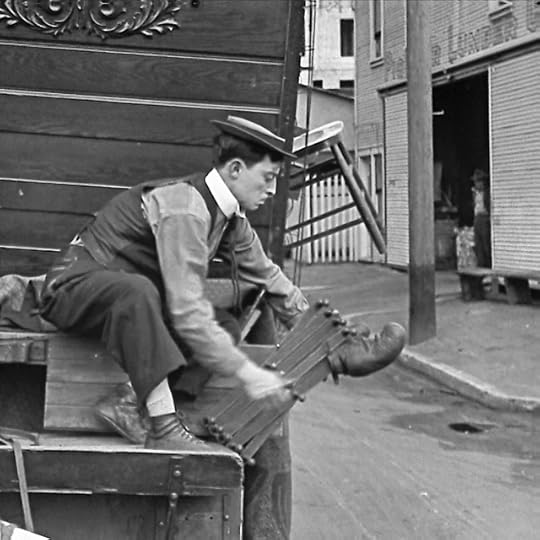

Lurking in doorways, left, heading south past the former Pioneer Lumber Co. at 1626 Cosmo in Hollywood, and heading west along 10th (now Olympic) past the side of the former E. A. Featherstone Auto Supplies Store at 958-960 S. Los Angeles St.
An army of police sneaks up behind Buster on New High Street beside the original Hall of Records Building (1911-1973) to the right, before the Civic Center was completely rebuilt, with a crowd of spectators sitting on the wall. The twin lampposts on the wall flank a sidewalk tunnel entrance into the former County Courthouse off camera further right. The landmark LA City Hall, later opening in 1928, would be built on the site to the left. Watching closely you’ll notice bystanders hunched down hiding beside almost every parked car, while the man standing between the cars at the far right even pops his head up like a gopher to stare at the camera.
Here’s a matching full view west down New High from Temple Street revealing the Hall of Records at back and the corner Court House (1891-1932). Jeffrey Castel de Oro first discovered this locale. I find it astounding this scene played out in view of these towering public buildings, now all gone, yet only a hint of the buildings appear onscreen. The crenelated tower of the former Los Angeles Times Building at 1st and Broadway (reported HERE) appears furthest back, while the former International Bank Building, the true skyscraper Bill Strother climbs for the long view shots appearing in Harold Lloyd’s Safety Last! (1923), stands to the left.

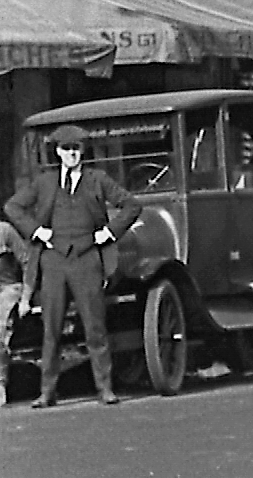

Now the grand champion gawker, legs spread, proudly posed hands on hips like the Jolly Green Giant, as Buster pulls a fast move on some traffic cops.
Buster staged this scene near the Rutland Apartments at 1839 S. Main (reported HERE). Cops is Buster’s only film with no interior scenes, staged at four different backlots and all across Los Angeles. I have identified essentially every scene in the movie.
[image error]
Buster heads east on Sunset at Detroit while a repairman works the wires and a curious child sits at the corner.
I find these bystanders endearing. You can imagine them running home to tell their families over dinner the excitement of watching Buster make a movie. Their presence reminds us of the romance of early Hollywood, when production standards were more relaxed, while confirming that when audiences are captivated by a well-told story they are immune to background distractions. Captured forever, the anonymous images of these curious onlookers will live on at the fringe of film history.
Charlie, Buster, and Harold each filmed a masterpiece at an alley you can still visit today. Please help support naming the alley by posting a review on Google Maps. Prototype alley sign design by noted Dutch graphic artist – Piet Schreuders. Download a 4-page brochure about the alley HERE. This video further explains the alley – if you can, please leave a thumbs up and share it with others.
A matching view east of the corner of Sunset and Detroit. The vintage corner building has since been demolished.
November 21, 2020
Doug and Mary, Hedda and Jed, The Beverly Hillbillies Hollywood Appeal
What popular 1960s sitcom mentions Nita Naldi, twice, in the same episode? Where Douglas Fairbanks is scolded for pulling pranks, and a prescient plea is made to spare a classic-era movie studio from the wrecking ball? Psychologists say conjuring nostalgia during stressful times, watching old movies and TV shows, is a healthy coping mechanism. So, feeling nostalgic and self-soothing, I recorded a random episode of The Beverly Hillbillies (1962-1971), just to revisit old times. Selecting Season 3, Episode 4, was a spectacularly lucky choice.


A classic “fish out of water” premise, the popular series revolved around the backwoods Jed Clampett family who strike oil on their Ozark homestead, and now nouveau riche, move to a mansion in Beverly Hills.

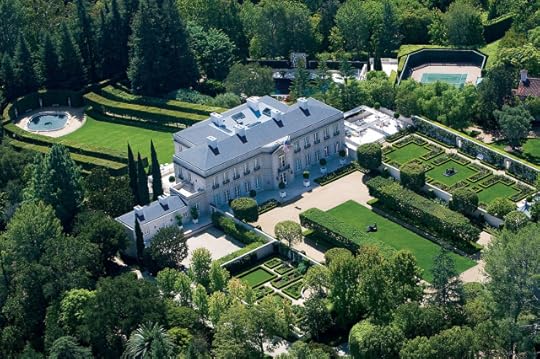
Entitled Hedda Hopper’s Hollywood (1964 – available on YouTube https://youtu.be/xaecYlyNm7A), the episode begins with a mock newscast, as a helicopter reporter flies around the Clampett estate.


Their “Beverly Hills” home, actually located at 750 Bel Air Road in Bel Air, recently sold for $150M. As reported by Lindsay Blake’s I’m Not a Stalker location website, the home also appeared as a location in Bing Crosby’s High Society (1956), and in Jerry Lewis’s Cinderfella (1960), before gaining immortal fame as the home to Jed and the rest of the Clampett kin.


The episode’s plot, and the helicopter news reporter’s story, concerns plans to bulldoze historic Mammoth Studios to build office towers instead, likely inspired by the recent development of Century City on the former backlot of 20th Century Fox. And who owns the studio? Why none other than Jed himself. Above, the reporter’s view of the at-risk studio, in fact being Warner Bros. in Burbank.


But Hollywood champion Hedda Hopper won’t let this stand. The news helicopter zooms in to her office in the foreground Guaranty Building at Hollywood and Ivar.
Within her office, Hedda delivers an impassioned appeal. “Mammoth Pictures is more than just a valuable piece of real estate. It’s a priceless chapter of Hollywood history, written by stars who the world will never, never forget. … a studio so rich in memories should and must be preserved.” Behind Hedda, left to right top row, are George Arliss, possibly Marie Dressler (thanks Steve Massa – can anyone confirm?), Douglas Fairbanks, John Barrymore, Lillian Gish, and Clara Bow. The bottom row, left to right, are Janet Gaynor, Wm. S. Hart, Mary Pickford, Rudolph Valentino (blocked from view), Hedda Hopper herself, and possibly Carole Lombard (can anyone confirm?). [Note: a reader shared Buster Keaton and Hedda both died the same day, February 1, 1966.]


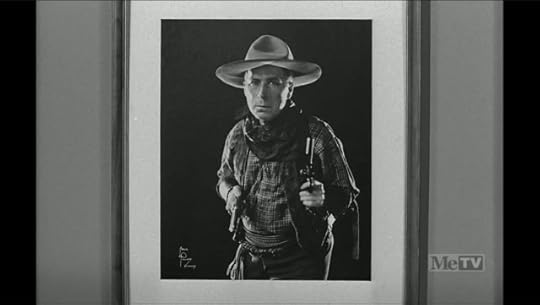


These loving close-ups of Barrymore and Gish, and of Hart, Pickford, and Valentino, flash onscreen during Hedda’s appeal.


Hedda finagles a meeting with Jed and his nephew Jethro Bodine, instructing them to visit the forecourt at Sid Grauman’s Chinese Theater (now TCL Theaters), to impress on them the weight of Hollywood history.


Once there, Jed and Jethro are shocked to see the forecourt has been vandalized, messing up some poor man’s SEEment (the proper pronunciation and spelling of the word). Bold rascals, they didn’t just leave their footprints, but handprints and names too, just to taunt this poor Sid fellow who must own the place. Diana Wynyard and Judy Garland appear center above, Bob Hope lower right.

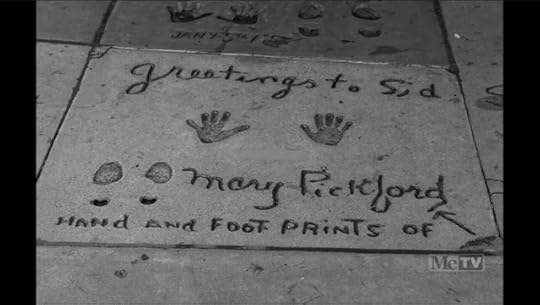
Above, Douglas Fairbanks and Mary Pickford, the premiere inductees. Poor Jed, he understands Doug was a skamp, but can’t believe Mary would stoop so low – “Clara Bow, yeah, she’s a little cut-up, frisky as a kitten, but sweet little Mary” he sighs.


Slight detour – as I report fully HERE, following Doug, Harold Lloyd was the second man, and only the fifth celebrity, to be honored at Grauman’s. Missing much of his right hand, Harold wore his prosthesis for the ceremony.

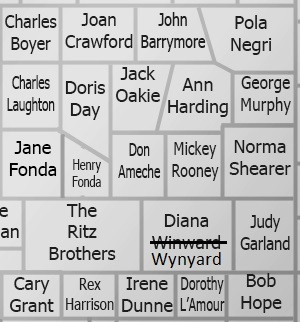
Note: the Me-TV and YouTube episodes are significantly different, with different dialog and scenes. Granny mentions Nita Naldi twice on Me-TV, around 18:26 and 24:08, but only once at 16:09 on YouTube. The forecourt scenes and dialog differ too. On Me-TV, Jed and Jethro speculate someone must have dared Doug (never one to refuse) to mess up Sid’s fresh SEEment during a premiere, leading Doug to dare Tom Mix, and so on, until all the stars, including poor Mary, overwhelmed by peer pressure, had vandalized the forecourt. Above, Mickey Rooney at center, with a guide to his neighboring signatures.
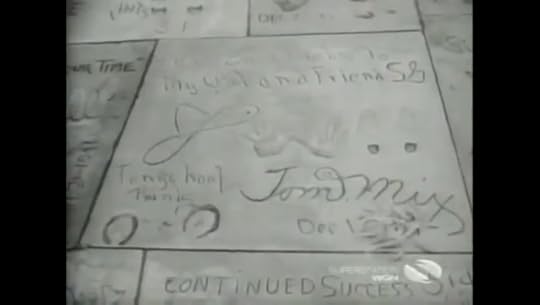
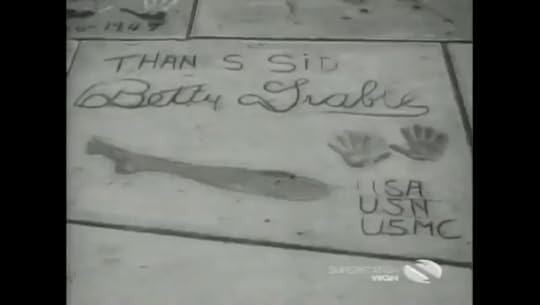
The YouTube version doesn’t blame Doug, but visits more handprints, where Jethro and Jed discuss Tom Mix and his horse Tony, Norma Talmadge, Gloria Swanson, Bill Hart, and some woman by the name of Betty Grable, exclaims Jethro, who stuck her whole leg in!
[image error]Returning to Hedda, she explains to Jed that as owner of the studio, many of those signatures were made by his stars. Does he want them to be remembered only by their footprints in that cement? Feeling personally responsible for “his” stars, and not wanting Mary and the others to be remembered in shame only for their vandalism, upstanding Jed decides to do the right thing and repair the forecourt.


Defending Mary’s honor, Jed nobly begins his repair work. When interrupted by a cop, Jed pleads for him to go easy on her. “You give me an hour and there won’t be a footprint in the whole place, and that’s a promise.” Above, a full guide to the forecourt footprints.


The episode also features views of a modest western movie backlot, which the Clampett’s naively assume is Clampett City, the town their banker Milton Drysdale promised to build once the studio is demolished.
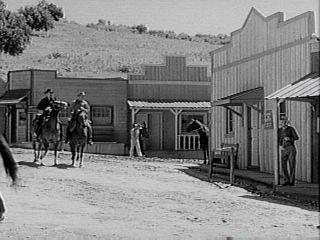

The backlot portraying Clampett City is reported to be the former Jack Ingram Ranch at 22255 Mulholland Drive in Woodland Hills. The sole image I’ve found reported to be filmed there, above left, generally matches the Clampett City frame at right.


The Mammoth Studio entrance was conveniently portrayed by the Filmways Studio where the show was filmed, now the Sunset Las Palmas Studios at 1040 N. Las Palmas Ave. (Note: this was originally the Hollywood Metropolitan Studios, where Harold Lloyd produced his feature films, beginning with Girl Shy (1924), after leaving Hal Roach.) Jed learns he acquired the studio during the Season 3 premiere episode, filmed extensively on the lot (YouTube – https://youtu.be/qRBwAY5tWgM).
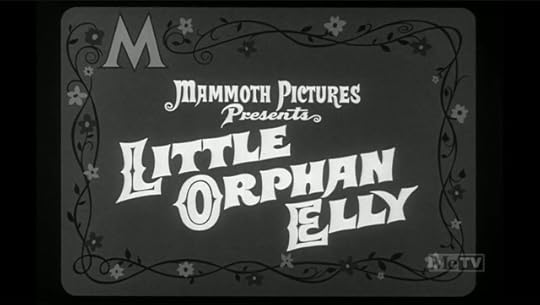


For a closing bit of fun, with the studio saved, Jed decides the best way forward is to film a movie himself, a silent melodrama Little Orphan Elly. Above, for the movie Mr. Drysdale portrays an evil banker who will forgive the mortgage if Elly’s character marries him. Granny had imagined Lillian Gish and John Barrymore in these roles.



Arriving in the nick of time, Honest Jed offers to pay off the mortgage, but the banker hires a seductress (portrayed in the film by Mr. Drysdale’s prim secretary Miss Jane Hathaway), the vamp with eyes no man can resist, to lure away the money. Granny had imagined Bill Hart and Nita Naldi in these roles.


But all ends well when a very Valentino-esque Jethro, with eyes no woman can resist, melts Jane in his arms with a seductive tango. Granny had envisioned Rudy himself for this role. Given Miss Hathaway’s unrequited crush on Jethro, she must have enjoyed dancing with him.
[image error]
Not something you see everyday – Jed and Hedda, Doug and Mary!
No doubt inspired by the Fox demolition creating Century City, the episode was also sadly prophetic, as the M-G-M and RKO-40 Acres backlots would fall to the wrecking ball in the decades after the show aired. But Hedda’s plea made over 50 years ago remains as true as ever – Hollywood history, so rich in memories, should and must be preserved!
Charlie, Buster, and Harold each filmed a masterpiece at an alley you can still visit today. Please help support naming the alley by posting a review on Google Maps. Prototype alley sign design by noted Dutch graphic artist – Piet Schreuders. Download a 4-page brochure about the alley HERE. This video further explains the alley – if you can, please leave a thumbs up and share it with others.
November 8, 2020
The Remarkable Charlie Chaplin Archives
Click to enlarge – auditioning dogs for A Dog’s Life.
The Charlie Chaplin Archives, housed in Bologna and accessible online, hosts thousands of rare photographs, production logs, scripts, and other fascinating studio records and documentation from Chaplin’s life and long career. Pick a favorite film, or subject of interest, and you can happily spend hours exploring these records firsthand.
Look at the enormous, respectful crowd, as Charlie stands on the SE corner of Sunset and La Brea auditioning dogs for A Dog’s Life (1918) on the front lawn of the beautiful home where his half-brother Sydney lived. The home came with the orchard property Chaplin purchased to build his studio at 1416 N. La Brea. The classic home on Sunset directly behind Charlie is now a Burger King (!), and stripmalls occupy all four corners of this once glamorous, citrus orchard – residential intersection.
[image error]Next, a crossword puzzle (from page 6) of the 28 pages of artwork and dozens of other promotional materials for City Lights (1931), with the answers further below in this post. Here’s a PDF link if you want to print it out for home use. The first clue, one across, seven letters is “First name of greatest comedian in Motion Pictures.” Hmm, “Buster” and “Harold” are both six letters, who could it be? 
October 25, 2020
Buster, Harold, Mabel, and Doug, and the murder of Wm. Desmond Taylor!
This post contains a variety of odds and ends. To begin, thanks to Tommy Dangcil we can see exactly where Buster Keaton staged a scene from Cops (1922) in front of the grand stairway leading to the former First Baptist Church in Hollywood. Look how the images above match perfectly – click to enlarge.
[image error]
Side view before the 1935 fire
Tommy is a Hollywood historian (and a feature motion picture lighting engineer) whose newly released third book Hollywood California Through Time compares rare vintage Hollywood images from his private collection with modern color views. I wrote a lengthy post detailing this church discovery (read more HERE), filled with distant or oblique views of the camera-shy church once standing at 6682 Selma Avenue in Hollywood, completely rebuilt in 1936 after a destructive fire. But with Tommy’s beautiful photo we can match Buster exactly to this lost landmark a century later – a ghost of a ghost. BTW, this scene immediately follows Buster’s escape from the Chaplin-Keaton-Lloyd Alley, see below.
Next, Harold Lloyd’s squabble-with-your-neighbors comedy short, Just Neighbors (1919), includes many scenes staged beside and even inside the grand and long-lost Southern Pacific train depot (read more HERE), and sidewalk scenes on long-lost Court Hill just steps from the former Bradbury Mansion – Rolin Studio, covered in my Lloyd book Silent Visions. But as seen streaming on the Criterion Channel, Harold’s barely legible mailbox address (lower right) confirms the above home still stands at 1127 N. Westmoreland Avenue.
This view north matches the distinctive uphill rise at the end of the street as Harold and co-star neighbor Snub Pollard arrive home. The narrow street still retains the wide median between sidewalk and curb.
Silent film superhero Ben Model of Undercrank Productions has released over twenty rare silent films, with more to come. His recent The Douglas MacLean Collection ended up matching Doug’s feature One A Minute (1921) with the same rural train station appearing later during Harold Lloyd’s Girl Shy (1924, above right). It turns out Mabel Normand (above left) portraying a star-struck girl from a small town in Illinois in The Extra Girl (1923), filmed at this station too, part of the Mack Sennett Collection Vol. One.
While Mabel barely catches her train to Hollywood (see her departing POV at left), Harold just misses his train, leading to his epic race by horse, motorcycle, and stolen car to stop an illegal marriage. Read more about the now lost Hynes station once located north of Long Beach HERE.
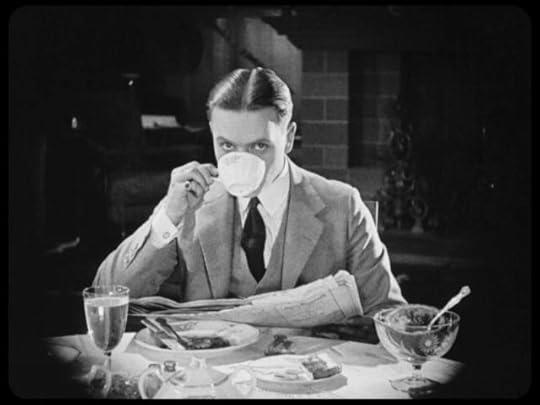

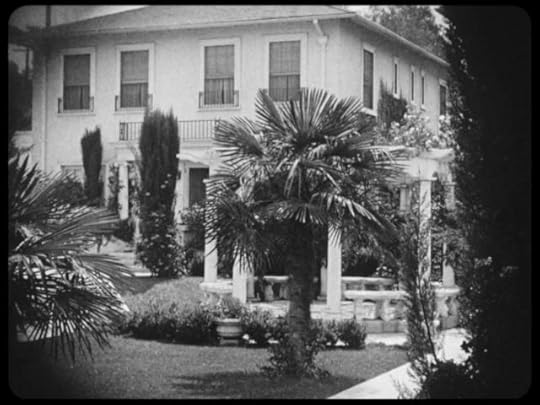
Last, included with Ben’s Douglas MacLean Collection is the modestly named A Trip Through the World’s Greatest Motion Picture Studios (1920) promoting the Thomas H. Ince Studio in Culver City. While this fascinating reality film deserves a lengthy post of its own, here’s a final tidbit. Portrayed as a loveable goof, always late for work, the film shows Doug gulp his morning coffee, then dash out his front door, along with a view of his apartment courtyard (all above).
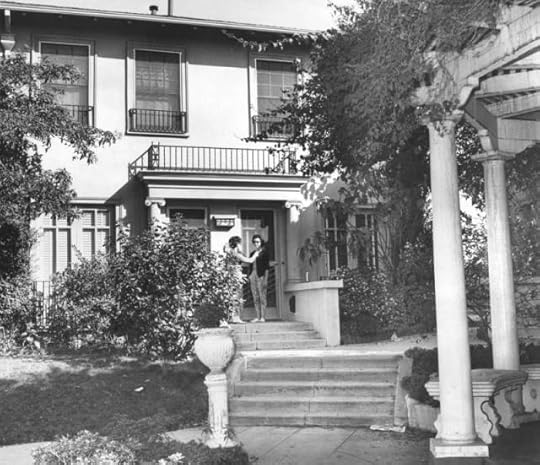


But where did Doug live then? At the same 400 A-B to 414 A-B South Alvarado courtyard of duplexes where silent film director William Desmond Taylor was notoriously murdered at his 404-B home in 1922 (upper left photo). Doug’s wife Faith is widely believed to have seen Taylor’s killer! Hearing a loud noise, she checked out her front door and saw someone leave Taylor’s home, whom she said was dressed “like my idea of a motion picture burglar.” So the movie provides real time glimpses of the future crime scene. Charlie Chaplin’s long-time leading lady Edna Purviance was also Taylor’s neighbor at the time. Note: the main graphic image above depicts the MacLeans as living across from Taylor. But the 2-12-1922 Los Angeles Examiner and other sources report their address as 406-B, adjacent to Taylor’s home. Doug’s movie frame exiting his front door seems to confirm he lived adjacent to Taylor, at the back of the courtyard. LAPL. LAPL.
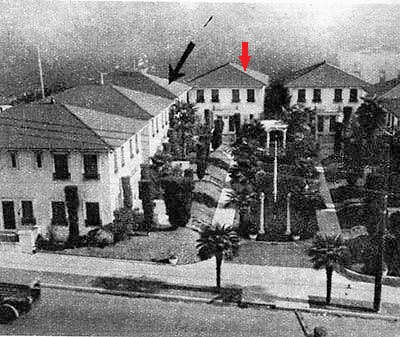

Poor Mabel was the last person to see Taylor alive the night he was killed. This photo view looking east (left) shows the courtyard entrance along Alvarado, where Mabel’s car was parked – the black arrow pointing to Taylor’s 404-B home, the red arrow pointing to 406-B. This supposedly corresponding shot (right) of Doug racing to his car was not filmed at this Alvarado entrance. Given the grade of the 400 block of Alvarado, and the steeply sloped front lawns across the street, Doug’s scene, which even shows a street corner, was staged elsewhere, I guess for a prettier view.
[image error]Buster’s scene in front of the church immediately follows his escape from the Chaplin Keaton Lloyd alley by grabbing a passing car one-handed.
Please help support naming the alley by posting a review on Google Maps. Prototype alley sign design by noted Dutch graphic artist – Piet Schreuders. Download a 4-page brochure about the alley HERE. This video further explains the alley – if you can, please leave a thumbs up and share it with others.
Below, the replacement church on Selma in Hollywood that opened in 1936.
October 11, 2020
Charlie Chaplin, Harold Lloyd, and Lyons & Moran – the “good” old days on New High Street



One of my all-time favorite discoveries are the young girls caught on camera intently watching Charlie Chaplin filming scenes from The Kid (1921) (read more HERE).
[image error]A closer study of Harold Lloyd’s early short From Hand to Mouth (1919) reveals broader views of where Chaplin filmed these scenes on New High Street north of downtown (read more HERE). But the early comedy team of Eddie Lyons (far left) and Lee Moran beat them both, filming a missing person comedy What A Clue Will Do at this same locale in 1917, providing vibrant and fascinating details of this working class neighborhood. For good measure, they even filmed at the Chaplin-Keaton-Lloyd alley (see below), again, years before the other comedians.
Lyons and Moran appeared in over 300 early films together under the Universal – Nestor and later Star Comedies banners. To begin, the clueless sleuths seek clues standing beside 645 New High Street, the same numbered doorway where Minnie Stearns wallops Charlie with her umbrella. It’s fun to see details from 100 years ago match perfectly.
With its wide sidewalks, grungy exteriors, and minimum traffic, being only two blocks long, this setting was a perfect locale for both Chaplin and Lloyd’s hard luck stories. The oval marks the Lyons & Moran filming spot, while the “T” intersection to the north at Alpine Street appears behind Harold.
The police chase Harold north past the corner of 641 New High (arrow), the same corner where reporter Edith Roberts searches for her lost notes.
Here both views look south, as Minnie continues to wallop Charlie.
Harold’s drive down the street provides a view of 640 New High to the east, where Eddie meets and flirts with Edith.
Looking north up the east side of the street, left, reveals the 636 New High home site (arrow) of the woman employing Lyons & Moran to find her lost “baby.” Spoiler, he’s really a giant, 30 year old barfly.
Again, Harold’s broader view reveals where Eddie chases after Edith, the arrow pointing to 632 New High.
Looking south, a cop whistles for Lyons & Moran to stop, while Harold chases after the villains, the decorative arched columns of 618 New High (box) appearing in both views.
Remarkably, the building at 618 New High remains standing. While the decorative arches are replaced by sliding metal doors, the upper windows (box) are unchanged.
Looking east along the 600 block of New High, from Ord Street at the left, to Sunset at the right, showing the 640, 636, 632, and 618 addresses, while the star marks the gateway at 645 where we meet Lyons & Moran and where Minnie wallops Charlie.
As I explain in my Lloyd book Silent Visions, Harold filmed many scenes from For Heaven’s Sake (1926) here as well, seen above running south beside the building still standing at the NW corner of Ord.




Given its “colorful” exteriors and close proximity to the Bradbury Mansion Rolin Studio, Lloyd likely filmed many other early (but sadly lost) films along New High. One rare surviving example is That’s Him (1918), included as a bonus to the Criterion Collection release of Lloyd’s The Kid Brother (1927). I’ve identified nearly every shot in the film, and hope to post about it some day, but for now, these views show the SE corner of Ord and New High, a bit north from where Lyons & Moran filmed. LAPL. USC Digital Library.
Jumping over to Hollywood, Lyons & Moran filmed at the Chaplin-Keaton-Lloyd alley, running down the rickety wooden stairway appearing beside Harry Houdini during his escape from the villains in The Grim Game (1919) (read more HERE).
Eddie and Lee even filmed at the top of these stairs, providing a clear view of the distinctive two story home once standing at 1645 Cosmo. The stairway was removed by the time Buster Keaton filmed Cops (1922) here.
A parting shot looking east in 1890 shows the back of the gateway on New High where we meet Lyons & Moran (yellow box), and still standing on the corner of Ord at 1001 Alameda Street (orange box), the world-famous Philippe The Original restaurant, home to the original French dipped sandwich. Huntington Digital Library.
[image error]Discovering Lyons & Moran recently this year has been an absolute thrill. Their early films document dozens of century-old locales, especially Waiting at the Church (1919) (left), which I plan to write about extensively. This prior Time Travelers post uses several of their films to highlight a single vintage photo. I want to thank Michael Aus for working with the Library of Congress to make these entertaining time travel films of Lyons & Moran available to eager fans. You can purchase What A Clue Will Do and other early films HERE, and more Lyons & Moran films HERE. Proceeds benefit the Niles Essanay Silent Film Museum.
Please help support naming the Chaplin Keaton Lloyd alley in Hollywood by posting a review on Google Maps. Prototype alley sign design by noted Dutch graphic artist – Piet Schreuders. Download a 4-page brochure about the alley HERE. This video further explains the alley – if you can, please leave a thumbs up and share it with others.
Below, a rare remaining building along New High, appearing with Lyons & Moran in 1917.
September 26, 2020
Buster Keaton’s Go West Desert – “Frozen” in Time
Vintage movies are time machines, preserving fashion styles, means of transport, and urban locales for us to marvel at decades later. But when filmed at a remote locale, they also remind us a passing century is merely an eye-blink in geologic time.


Buster Keaton filmed the ranch scenes for Go West (1925) in a remote Arizona desert. When visiting there today, dedicated EPA attorney and devoted Keaton fan Marie Muller was struck by the timelessness of the setting. The blue sky, red dirt, and towering mountains represented in her vivid color photographs all must have looked exactly the same to Buster and his crew nearly ten decades before. Above, we are introduced to Keaton’s favorite leading lady, Brown Eyes the cow.
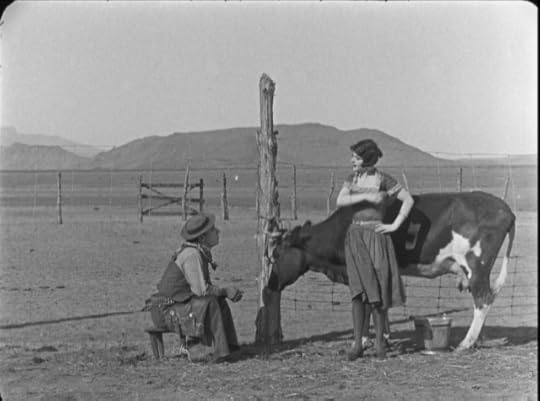

[image error]I was privileged to include not only these but many more of Marie’s beautiful photos in my new Go West visual essay prepared for the new Eureka Entertainment Masters of Cinema box set release of Go West, along with Keaton’s Our Hospitality and College. With thanks to Kino-Lorber for graciously sharing, the visual essay I prepared for them about College is also included in the new Eureka release.


In June 1925, Keaton and crew headed east from Hollywood to Kingman Arizona more than 300 miles away. Keaton filmed on location far more than any other comedian, staging productions all across California, and later in Oregon and New York. The Go West production was headquartered in Kingman, with easy access to food and supplies, and even ice to keep the cameras cool in the desert heat. Above, Buster first meets Brown Eyes as she limps by with a rock stuck in her hoof.
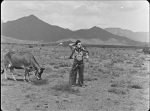
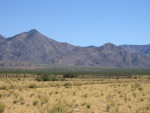
While Kingman served as the entry point for Keaton’s crew, all of the ranch scenes, comprising nearly the entire Arizona production, were staged at Tap Duncan’s Valley Ranch more than 50 miles north of Kingman, only accessible even today by Antares Road, a lonely dirt path. Imagine, any necessary prop or production item required back then during filming involved a 100 mile round trip through the desert to Kingman and back.


The cattle loading scenes were filmed in Hackberry, about 20 miles NE from Kingman, and 30 miles south of the Valley Ranch. Located along historic Route 66, it’s easy to visit today. While Buster spent much time here filming in 1925, he did not get his kicks on Route 66 – the famous highway wasn’t given that route number until the following year.
My visual essay contains many other new discoveries not covered in my book Silent Echoes, including guest blogger Jeffrey Castel de Oro tracking down the LA Arts District setting above where Buster is first inspired to “Go West.”
[image error]Highly recommended, the Eureka Entertainment Masters of Cinema set not only features restored copies of Our Hospitality, Go West, and College, but nearly a dozen new programs, audio commentaries, and visual essays each specially commissioned for the release. My special thanks to Marie Muller for sharing her photos. I also applaud her sense of adventure. While I once easily made a side-trip to Hackberry during a visit to the Grand Canyon, she braved a single lane desert dirt road for hours and back to visit the former Valley Ranch filming site. Visit where Keaton filmed, virtually on Google Maps, further below.
Please help support naming the Chaplin Keaton Lloyd alley in Hollywood by posting a review on Google Maps. Prototype alley sign design by noted Dutch graphic artist – Piet Schreuders. Download a 4-page brochure about the alley HERE. This video further explains the alley – if you can, please leave a thumbs up and share it with others.
Below, a view east near where Keaton filmed. Swivel the view 360 degrees for a full look.
September 7, 2020
Time Travel to 1919 Hollywood
[image error]Imagine when Hollywood was still a town, with stately homes, dirt roads, orchards, and scores of vacant lots. Vintage photos are compelling, but silent films are true time machines, placing you at the spot to see and breathe a slice of reality. Working with the Library of Congress, Michael Aus has made such early films available to the public (his eBay link), including several early Lyons-Moran comedies. Watching them is a revelation. In particular, his release Waiting at the Church (1919) is one of the most visually consequential silent films I’ve ever seen, with scenes filmed all around La Brea, Highland, and nascent Hollywood Boulevard (above, from Cahuenga to Ivar). Scratching the surface, this introductory post selects just one scene per film to illustrate Hollywood’s past. HollywoodPhotographs.com.


To begin, groom Eddie Lyons and best man Lee Moran flee for an urgent errand at the opening of Waiting at the Church, staged beside the former First Methodist Episcopal Church on the corner of Hollywood and Ivar. California State Library.
Lyons and Moran appeared in over 300 films together under the Nestor and later Star Comedies banners. The church was demolished in 1923 for the Guaranty Building standing there today.


Cinematically mismatched character actors approach the corner of Hollywood and Ivar, beside the original branch library, in Mrs Plum’s Pudding (1915 !!). LAPL.
Opening in 1907, the original branch library was relocated in 1922, to allow a more modern library facility to be built on the corner in 1923. This structure itself was moved half a block south to 1623 Ivar in 1939. That facility was later destroyed by arson in 1982, with a new library opening at 1623 Ivar in 1986. A streamline moderne building stands on the NW corner of Hollywood and Ivar today, it’s building permit issued late in 1939.


Eddie Lyons plays a country bumpkin in Taking Things Easy (1919), looking north up Cahuenga toward the corner of Hollywood Blvd. Note the awning for “GREEN ROOM CAFE” in both images. Marc Wanamaker – Bison Archives.
This corner once existed because the remainder of the street was still empty lots!


During early December 1919, Charlie Chaplin filmed scenes here discovering an abandoned baby for The Kid (1921). A popular filming spot, in part due to the limited alternative locations at the time, the same setting appears in several early Universal films, including this matching view from Eleanor’s Catch (1916).
[image error]At back, that corner iron post to the left of Charlie is still present (right), part of the Chaplin-Keaton-Lloyd Alley. At the time the east-west cross arm of the alley was nearly as long as the north-south stretch. In 1919 Hollywood was growing so quickly that even by the early 1920s many original landmarks were lost to progress. This PDF tour documents the 1600 block of Cahuenga, the busiest silent film location street in town.
I want to thank Michael Aus for working with the Library of Congress to make these entertaining time-travel films available to eager fans. Visit his eBay listing where you can purchase these films directly. Proceeds from the sale benefit the Niles Essanay Silent Film Museum.
Also thanks to silent film super-hero Ben Model whose Undercrank Productions has released over 20 rare silent movie DVDs. His Silent Comedy Watch Party, a live-streamed silent comedy film show with live piano accompaniment, hosted each Sunday at 3 pm EDT with co-host film historian Steve Massa, provides laughs and sense of community to an appreciative shelter-in-place audience. Ben and Steve screened Waiting at the Church recently – you can watch it at their YouTube link HERE.
Last, another nod of gratitude to accomplished authors, photo archivists, and historians Marc Wanamaker and Bruce Torrence, for preserving priceless views of Hollywood’s past.
Please help support naming the Chaplin Keaton Lloyd alley in Hollywood by posting a review on Google Maps. Prototype alley sign design by noted Dutch graphic artist – Piet Schreuders. Download a 4-page brochure about the alley HERE. This video further explains the alley – if you can, please leave a thumbs up.

















